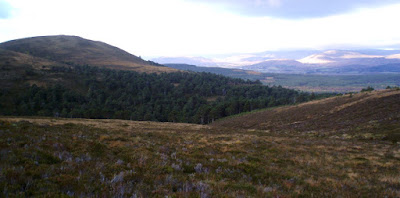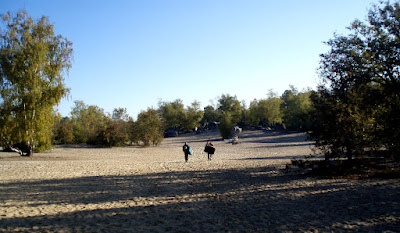Another little post from the Arran Voice series I am writing. This one appeared in September's issue.
Retreat.
I’m walking alone at sunset close to my house, binoculars hanging heavy on my neck. The track behind the beach is pitted with the frost encrusted prints of animals and people. Paws, hooves and boots have been strutting back and forth along the lonely shore. I’m looking for evidence of otters, and pause to hunt among the rocks next to a drainage culvert. I find what I’m after, pungent spraint daubed on to a smooth lump of granite. There is evidence of several visits to this messaging post, and I follow the ditch upstream to a thicket of brambles. I look for prints in the muddy bank but find nothing. If an otter came this way, it did not exit the burn at this point, but must have continued to the farmland beyond. I don’t follow. An otter’s holt is a sacred space, protected through secrecy and by law.
Winter is a great time for watching otters on Arran, as the short days bring their most active hours within reach of a normal human day. There are fewer dogs and people about too. The otter I am tracking today is a female with a young cub in tow. She is naturally shy, but I have seen them in the water from Clauchlands to Corriegills. The cub is only a few months old but already an efficient hunter of crabs and shrimps. I don’t spot them often, but the traces of their presence are left in piles of fishy spraint along the back of the beach above the high tide mark.
Sunbathing.
Not all otters insist on secrecy. In Kildonan, a pair of cubs curl up in full view of villagers on a flat rock marooned by the rising tide. It is early spring now, and the sun is warming the volcanic dykes that jut out to sea. This rock is a favourite sleeping place and the young otters, disguised as piles of brown seaweed, doze in peace while their mother forages amongst the surf. Their tidal alarm clock is set- the rising waves lap around them until they wake to foamy splashes. Mother appears, and the family begins a daily ritual of play that must end every siesta. I call this time “Otter O’clock”. I have no idea why this family is so predictable, or why they are less secretive than other otters, but they regularly delight visitors and locals with their bold play in broad daylight.
Feeding Time.
As the Kildonan cubs develop, their presence begins to dominate the coast around the village. Locals tell me they have never seen more otter activity in the area than now. The hungry family spends hours in the water, fishing almost constantly for crabs, blennies and other small morsels. They patrol every sheltered bay methodically, diving again and again with relentless appetite. Lying on their backs in the water, each catch is quickly crunched up before they porpoise down to the sea bed for the next course.
Otters have a rapid metabolism, perhaps to keep warm in cold water. Like teenagers, they live fast, going through episodes of intense activity, interspersed with vital periods of rest. They must eat well, and prefer small and easily caught meals, tending not to waste energy chasing the bigger prey. Their strong jaws and heavy molars are powerful tools for crushing the hard shells of crustaceans. Their spraint is packed with the tiny bones of fishes and broken shells of crabs and shrimps. The Kildonan family hunt for several hours a day.
End of an era.
It is midsummer, and all good things must come to an end. The Kildonan cubs are now indistinguishable from their mother. I calculate that they are well over a year old. Recently while the family has been at play I have noticed a fourth otter, loitering a few hundred metres away. Days pass and the intruder is still there, a curious presence in the background. It is a powerful male, and his increasing interest in the family shows that there is a change in the air. Reluctantly I go away for a week and when I return the favourite rock is deserted.
Now there is a different regime in the village. A solitary otter fishes the sheltered bays, but it is not always alone. When the large male appears, the two embrace playfully. There is a tumble of shiny brown bodies in the water and a boisterous game of chase begins amongst the rocks and pools. Then, they fish alongside each other for an hour or so, before smaller of the two slips away.
I do not know what has happened to the Kildonan family. Did the mother drive the cubs away? Did she leave and am I watching one of the cubs playing with the male? Otters are hard to tell apart unless heavily scarred, or as in the case of the male, distinctive by their size. He has a powerful bullish head and neck, his back humped and broad. I wonder if the smaller otter is a female in season. Only time will tell.
Fight.
Male otters live a rough life often shortened by violence. Upon leaving the safety of their family they travel long distances, sometimes for years, searching for their own territory. Many die before they find it: in road traffic accidents, in fights with dogs, or at the hands of other male otters. A male may inhabit the territories of several females, the limiting factor on territory size being what he can defend.
Late this summer I witnessed a fight. The violence was undeniable. Canines flashed in the sunlight, and the two screamed their aggression as they tore at each others throats. Even as the loser turned and fled, he was pursued relentlessly through the water at an incredible speed. I wondered if he would get away, and what would happen if he didn’t. Two years ago a woman from Kildonan found a young male otter with terrible wounds. He was handed to Hessilhead Wildlife Rescue Centre, but did not survive his injuries.
New life.
Autumn has closed in around us and the brutal weather has made finding otters hard, but I’m seeing evidence that the circle of life continues. Otter cubs are born throughout the year. The gestation period for otters is short- cubs are born helpless and blind, and are tucked up securely in the den for months. They are too weak at first to play in the currents, and even when they are six months old they will avoid rough weather. A female with a wild rocky territory in the Southend has a growing cub. They have been very shy through the summer, but as the tourists depart they are becoming easier to find. The cub is increasingly brave in the surf, strong enough now to hunt amongst the rougher breaks. These two still have several months together and I’m looking forward to watching them.
Meanwhile the solitary otter at Kildonan no longer receives the attentions of the male. Fishing expeditions are hurried and businesslike. It works only the best bays and ignores the less fruitful locations. I fantasize that somewhere in the tangle of wooded cliffs there is a waiting family, squeaking and blind, dependent on mothers milk.
Otter Facts:
- All wild otters in Britain are the species Lutra lutra, although they inhabit diverse habitats, from the coast to lochs and inland river systems.
- Otter numbers declined drastically during the 20th century due to pollution and persecution. Numbers are now on the increase thanks to legal protection and cleaner coasts and waterways.
- The greatest threat that otters face in the 21st century is still pollution. Roads also claim a number of casualties each year, including on Arran.
- Otters are protected by law. It is illegal to disturb or harass an otter or damage its holt. For more information see the SNH Website: http://www.snh.org.uk/publications/on-line/wildlife/otters/law.asp
- Arran is one of the best places in the country to watch otters, as it is thought that every stretch of coastline has a resident otter. You will need a good pair of binoculars and patience. Dawn/sunset or a rising tide are the best times of day to see them.












































